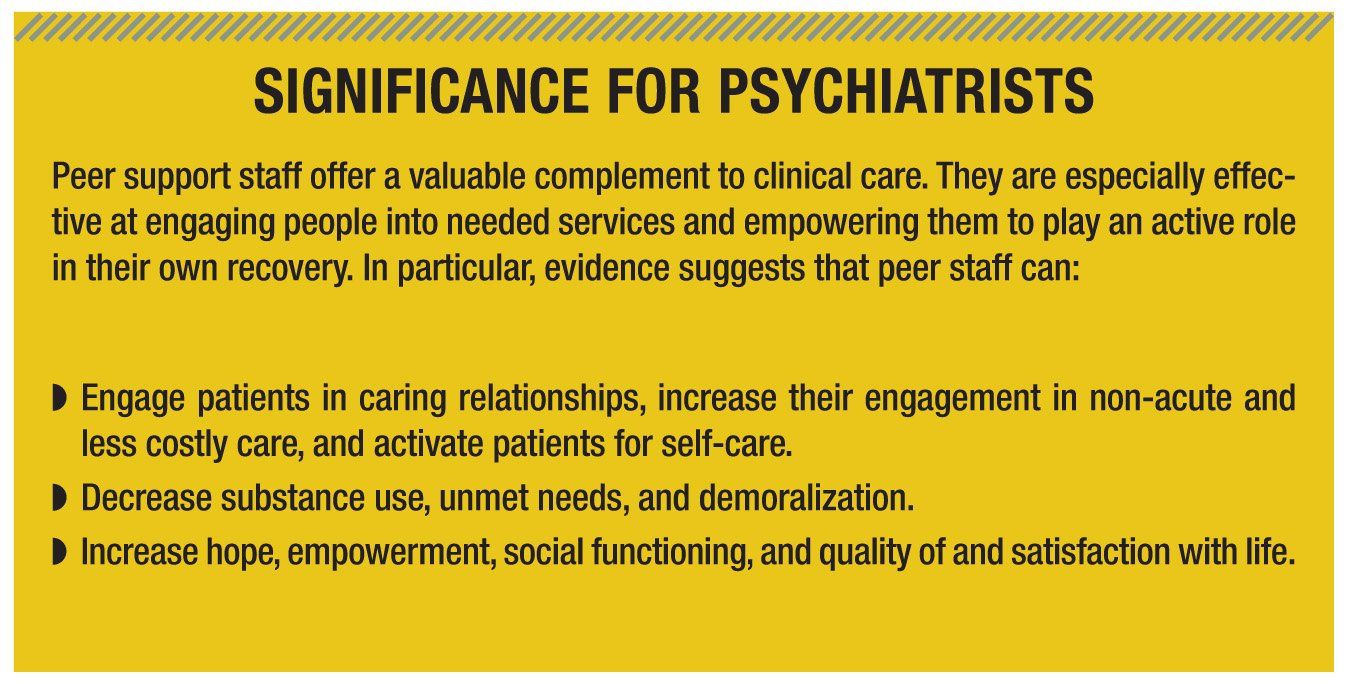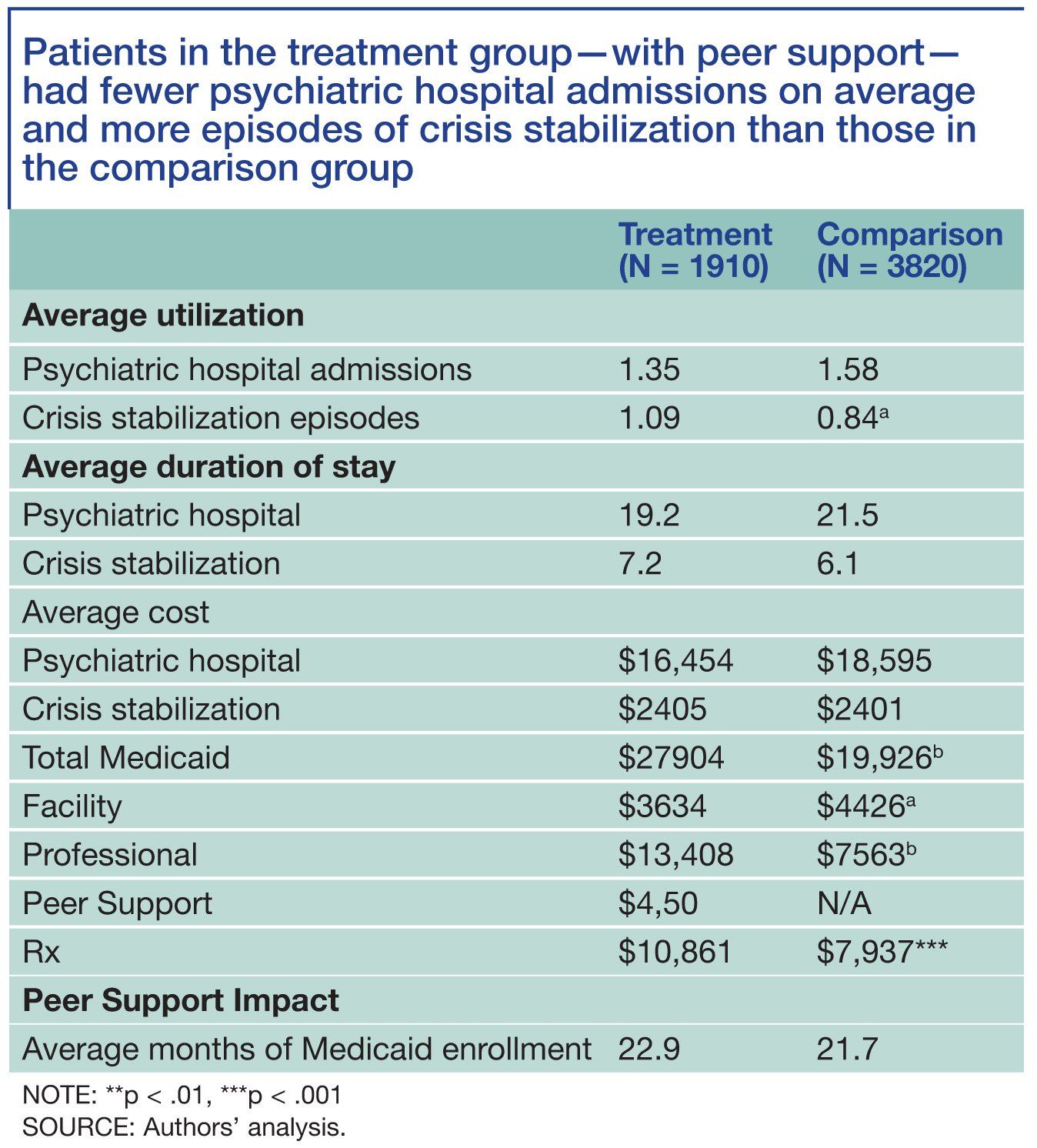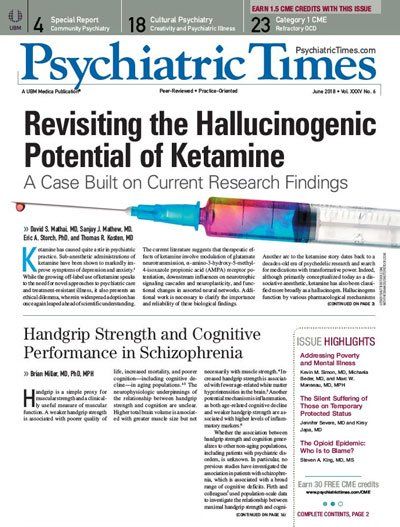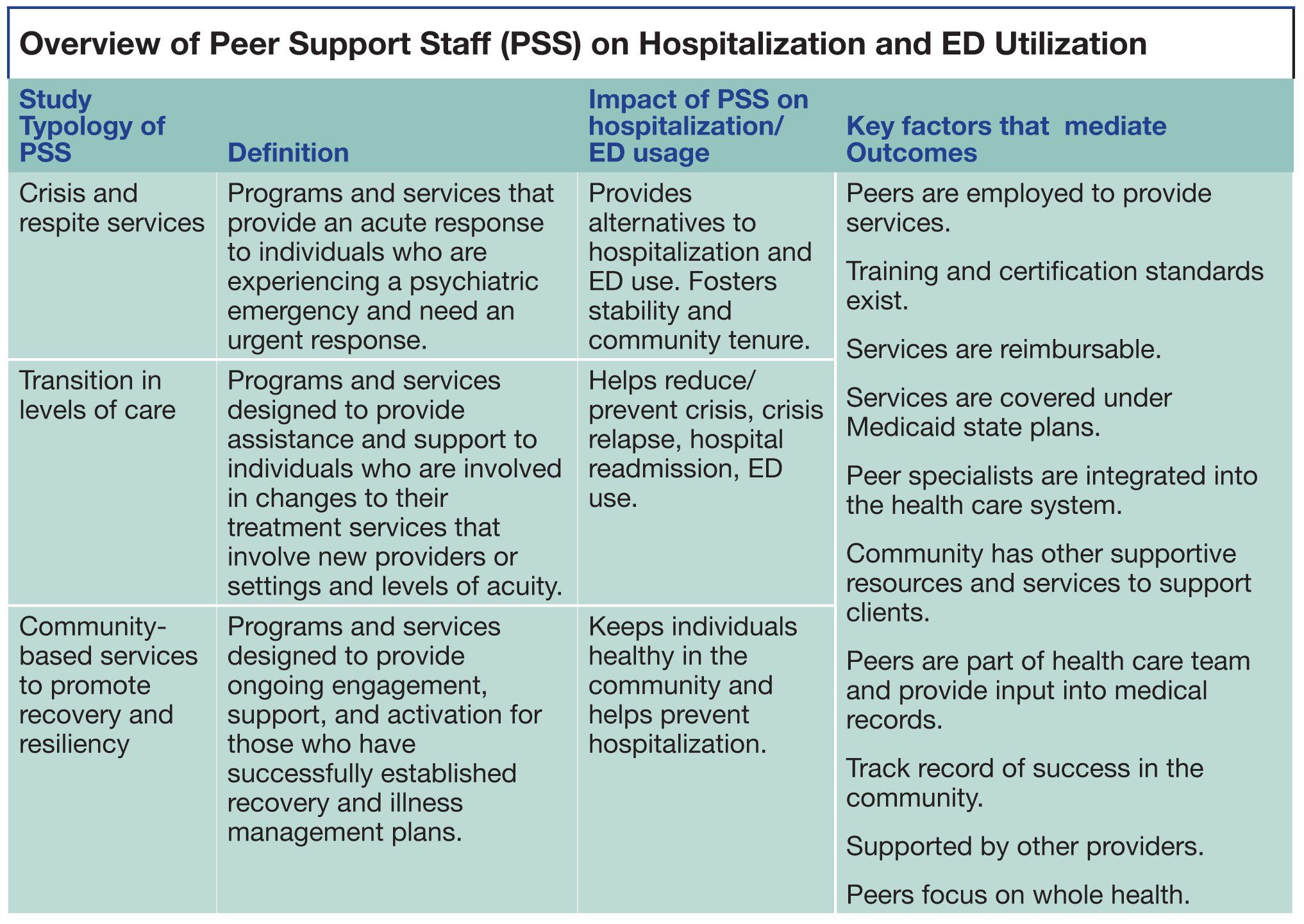Publication
Article
Psychiatric Times
Revisiting the Rationale and Evidence for Peer Support
Author(s):
The authors argue that that stating that peer support “lacks evidence” is simply not accurate.
A recent issue of Psychiatric Times featured an opinion piece by D.J. Jaffe who argued that there is little empirical support for the effectiveness of paid peer-support staff-persons in recovery from mental illnees who are trained to provide support to others-on the outcomes of “homelessness, arrest, incarceration, violence, and needless hospitalization.”1 In this article, we rebut Mr Jaffe’s argument by revisiting the rationale and evidence base for peer support.
While we agree that the government needs to fund more research on this important topic, we argue that stating that peer support “lacks evidence” is simply not accurate. In fact, as we will explain below, over 30 studies have found positive effects in numerous outcome domains. But first it is important to understand the nature and intended impact of this form of service delivery.
Rationale for peer support
SIGNIFICANCE FOR PSYCHIATRISTS

Patients in the treatment group—with peer support— had fewer psychiatric hospital admissions on average and more episodes of crisis stabilization than those in the comparison group

The rationale for peer support is neither new nor limited to psychiatry. Paid peer support has been around since the birth of the discipline in the late 18th century, with the hiring of recovered patients as staff identified as one of the most essential components of “moral treatment.”2 Harry Stack Sullivan continued this practice in his hospital in the 1920s, while the milieu therapy models that dominated psychiatry for the following decades relied in large part on the benefits of peer support and role modeling.
Outside of psychiatry, the Institute of Medicine reports that various forms of peer support can be found in virtually every branch of medicine that deals with chronic conditions, from asthma and cancer to diabetes and hypertension.3 The rationale here is simple; as explained by Fisher and colleagues4 in a recent review, persons with chronic illnesses spend about 6 hours every year in a health professional’s office, while spending the remaining 8760 hours of the year living with and trying to manage their health conditions. In psychiatry, this ratio is likely much less. Whether it is diabetes or mental illness, helping someone to live well with a serious illness is different from treating the illness, and it takes a different investment of time and effort. Simply put, people living with serious mental health conditions need more assistance and support than can be provided by a physician alone.
In psychiatry, as in other areas of chronic illness management, that “more” is typically provided by paraprofessionals. In medicine, there is currently rapid growth in the hiring of community health workers to assist patients with all manner of conditions to engage in self-care and to navigate complex health systems. In public psychiatry, paraprofessionals spend the most time with persons with chronic conditions, but usually have little to no training.
Training and hiring persons in recovery to provide peer support represents a win-win situation for resource-strapped systems. Patients receive support from trained peers who instill hope, model self-care, and help navigate the health care system. Peer support providers are gainfully employed in a role that supports their own recovery by allowing them to do personally motivated work. Systems gain a trained, effective workforce that pushes providers beyond the basic outcomes of decreased homelessness, incarceration, and hospitalization to include other outcomes that also matter to patients and their loved ones, ie, those associated with reclaiming a meaningful life.
To aspire to help persons with mental illnesses to establish meaningful lives is not to overlook or minimize the need to address homelessness, incarceration, and hospitalization. Because many have walked in their shoes, peer-support staff are especially expert in forging caring relationships with people who are overcome by the direst of circumstances and who have not responded to traditional approaches. Peer-support staff can effectively engage patients because they understand how they live (all too often on the street or in shelters) and offer practical help with basic needs and everyday living. In contrast to coercive measures that further erode patients’ sense of self and basic dignity by focusing solely on illness, peer-support staff can earn patients’ trust by providing assistance with day-to-day struggles, offering a more effective and sustained pathway to needed care than 2-week involuntary inpatient stays.
The evidence for peer support
It should be no surprise that the CMS study Jaffe references found that deploying peer staff increased the use of crisis services while decreasing hospitalizations.5 This increase in service use was a positive outcome for persons who otherwise were disconnected from all outpatient treatment. Perhaps it is on this score, above all, that the effectiveness of peer services has been shown most consistently.
Related: Mini Quiz: Peer Support and Mental Illness
When reviewing this evidence, it is important to recognize that neither peer nor non-peer non-clinical staff “treat” mental illness, that is not their role. Peer-support staff complement clinical care; their role is to instill hope, engage patients in self-care and health services, help them navigate complex and fragmented systems, and promote their pursuit of a meaningful life. When assessed on their ability to do these jobs for which they have been trained, peer-support staff clearly demonstrate effectiveness. The Table provides examples of the roles peer-support staff have played that have garnered consistent evidence in improving patient outcomes.6 To date, over multiple studies have found that peer staff who are working in peer-specific roles are better able to engage people in caring relationships7–8; improve relationships between clients and outpatient providers, thus increasing engagement in non-acute and less costly care9–17; decrease substance use, unmet needs, and demoralization8,11,17–18; and increase hope, empowerment, self-efficacy, social functioning, quality of and satisfaction with life, and activation for self-care.8,11–13,16,18–30
Patient-care outcomes
Why would these kinds of gains not be worthy of funding? Presumably because they have yet to be connected directly to reductions in the negative outcomes of arrest, incarceration, and violence. But these poor outcomes are more reflective of societal and systemic failures than of mental illness per se. They are due primarily to long-standing discrimination that has resulted in a lack of parity in funding for community-based mental health care.
This becomes obvious when one looks beyond the borders of the US. Homelessness, arrests, and incarceration are not attributable to mental illness alone, because they are not significant problems for persons with mental illness in most other developed countries. Mental illness alone poses minimal risk for violence (around 4%).31 Mass shootings are more a result of our failure to control access to assault weapons than a failure to treat mental illness. As Zakari12 pointed out in the Washington Post, the incidence of mental illness in the US is the same as that of the UK, yet the rate of gun violence in the US is 40 times that of the UK. Surely, unaddressed factors other than mental illness contribute significantly to such poor outcomes.
Foremost among these is the long-standing stigma against persons with mental illnesses that has resulted not only in the lack of adequate funding for community-based care but also acts as a barrier to accessing what care is available sooner, which might prevent the need for more intensive care later on. Homelessness, incarceration, and violence among persons with mental illness are more of a consequence of our failure to accord such persons the rights of dignity, respect, and full citizenship that is their birthright than to mental illness per se.
Conclusion
No one would deny a person in recovery from cancer, or a person living with diabetes, the opportunity to contribute to the shaping and delivery of cancer or diabetes care. Persons in recovery from mental illnesses have insider knowledge of what it takes to have a life well lived with mental illness. In fact, two of the most influential visionaries in the history of mental health policy, Dorothea L. Dix and Clifford W. Beers32 had their own experiences of mental illness. Based on the credibility and trustworthiness fostered by their lived experience, their passion to give back, and their dedication to making recovery a reality for others who suffer with mental illness, other people in recovery (ie, peers) can also make invaluable contributions to better outcomes by advocating for, transforming, expanding, and providing effective mental health services.
Disclosures:
Dr Davidson is Professor of Psychiatry, Yale University School of Medicine; Dr Chinman is Research Health Scientist, VA Pittsburgh Healthcare System and Senior Behavioral Scientist, RAND Corporation; Dr Farkas is Professor, Center for Psychiatric Rehabilitation, Boston University; Dr Ostrow is CEO, Live & Learn, Inc, Morro Bay, California; Dr Bellamy is Associate Professor of Psychiatry, Yale University School of Medicine; Dr Cook is Professor and Ms Jonikas is Program Director, University of Illinois at Chicago College of Medicine; Mr Rosenthal is Executive Director, New York Association of Psychiatric Rehabilitation Services; Ms Bergeson is Principal, Recovery, Resilience, Engagement and Activation Partners, LLC, Lake, Michigan; Dr Daniels is Senior Study Director, Westat, Cincinatti, Ohio; and Dr Salzer is Professor of Rehabilitation Sciences, Temple University College of Public Health, Philadelphia, Pennsylvania.
References:
1. Jaffe DJ. Jury is out on paid peer support for people with mental illness. Psychiatric Times. 2018. http://www.psychiatrictimes.com/blogs/jury-out-paid-peer-support-people-mental-illness. Accessed April 12, 2018.
2. Weiner DB. The apprenticeship of Philippe Pine: a new document, “Observations of Citizen Pussin on the Insane.” Am J Psychiatry. 1979;36:1128–1134.
3. Institute of Medicine. (2012). Living Well With Chronic Illness: A Call for Public Health Action. https://www.nap.edu/catalog/13272/living-well-with-chronic-illness-a-call-for-public-health. Accessed April 12, 2018.
4. Fisher EB, Tang PY, Coufal MM, et al. Peer support. In Daaleman TP, Helton, MR, Eds. Chronic Illness Care: Principles and Practice. New York: Springer International Publishing; 2018: 133–146.
5. Landers G, Zhou M. The impact of medicaid peer support utilization on cost. Medicaid Medicare Res Rev. 2014;4:E1–E14.
6. Chinman M, George P, Dougherty RH, et al. Peer support services for individuals with serious mental illnesses: assessing the evidence. Psych Serv. 2014;65:429–441.
7. Sells D, Davidson L, Jewell C, et al. The treatment relationship in peer-based and regular case management for clients with severe mental illness. Psych Serv. 2006;57:1179–1184.
8. Felton CJ, Stastny P, Shern DL, et al. Consumers as peer specialists on intensive case management teams: impact on client outcomes. Psych Serv. 1995;46:1037–1044.
9. Clarke GN, Herinckx HA, Kinney RF, et al. Psychiatric hospitalizations, arrests, emergency room visits, and homelessness of clients with serious and persistent mental illness: findings from a randomized trial of two ACT programs vs usual care. Mental Health Serv Res. 2000;2:155–164.
10. Sledge WH, Lawless M, Sells D, et al. Effectiveness of peer support in reducing readmissions of persons with multiple psychiatric hospitalizations. Psych Serv. 2011;62:541–544.
11. Craig T, Doherty I, Jamieson-Craig R, et al. The consumer-employee as a member of a Mental Health Assertive Outreach Team: I. clinical and social outcomes. J Mental Health. 2004;13:59–69.
12. Druss BG, Zhao L, von Esenwein SA, et al. The Health and Recovery Peer (HARP) Program: a peer-led intervention to improve medical self-management for persons with serious mental illness. Schiz Res. 2010;118:264–270.
13. Klein AR, Cnaan RA, Whitecraft J. Significance of peer social support with dually diagnosed clients: findings from a pilot study. Res Social Work Pract. 1998;8:529–551.
14. Min SY, Whitecraft J, Rothbard AB, et al. Peer support for persons with co-occurring disorders and community tenure: a survival analysis. Psych Rehab J. 2007;30:207–213.
15. Croft B, IËsvan N. Impact of the 2nd story peer respite program on use of inpatient and emergency services. Psych Serv. 2015;66:632–637.
16. Cabassa LJ, Camacho D, Vélez-Grau CM, et al. Peer-based health interventions for people with serious mental illness: a systematic literature review. J Psych Res. 2017;84:80–89.
17. O’Connell MJ, Sledge WH, Staeheli M, et al. Outcomes of a peer mentor intervention for persons with recurrent psychiatric hospitalization. Psych Serv. (In press.)
18. van Vugt MD, Kroon H, Delespaul PA, et al. Consumer-providers in assertive community treatment programs: associations with client outcomes. Psych Serv. 2012;63:477–481.
19. Cook JA, Copeland ME, Floyd CB, et al. A randomized controlled trial of effects of Wellness Recovery Action Planning on depression, anxiety, and recovery. Psych Serv. 2012;63:541–547.
20. Cook JA, Copeland ME, Jonikas JA, et al. Results of a randomized controlled trial of mental illness self-management using Wellness Recovery Action Planning. Schiz Bull. 2012;38:881–891.
21. Cook JA, Steigman P, Pickett S, et al. Randomized controlled trial of peer-led recovery education using Building Recovery of Individual Dreams and Goals through Education and Support (BRIDGES). Schiz Res. 2012;136:36–42.
22. Jonikas JA, Grey DD, Copeland ME, et al. Improving propensity for patient self-advocacy through Wellness Recovery Action Planning: results of a randomized controlled trial. Comm Ment Health J. 2013;49:260–269.
23. Pickett SA, Diehl SM, Steigman PJ, et al. Consumer empowerment and self-advocacy outcomes in a randomized study of peer-led education. Comm Ment Health J. 2012;48:420–430.
24. Cook JA, Copeland ME, Corey L, et al. Developing the evidence base for peer-led services: changes among participants following Wellness Recovery Action Planning (WRAP) education in two statewide initiatives. Psych Rehab J. 2010;34:113–120.
25. Kidd SA, Virdee G, Mihalakakos G, et al. The Welcome Basket revisited: testing the feasibility of a brief peer support intervention to facilitate transition from hospital to community. Psych Rehab J. 2016;39:335–342.
26. Chinman M, Oberman RS, Hanusa BH, et al. A cluster randomized trial of adding peer specialists to intensive case management teams in the Veterans Health Administration. J Behav Health Serv Res. 2015;42:109–121.
27. Salzer MS, Shear SL. Identifying consumer-provider benefits in evaluations of consumer-delivered services. Psych Rehab J. 2002;25:281–288.
28. Mahlke CI, Priebe S, Heumann K, et al. Effectiveness of one-to-one peer support for patients with severe mental illness-a randomised controlled trial. Eur Psych. 2017;42:103–110.
29. Corrigan PW, Kraus DJ, Pickett SA, et al. Using peer navigators to address the integrated health care needs of homeless African Americans with serious mental illness. Psych Serv. 2017;68:264–70.
30. Institute of Medicine. Improving the Quality of Health Care for Mental and Substance Use Conditions. Washington, DC: Institute of Medicine; 2006.
31. Zakari F. Talking About Mental Health After Mass Shootings Is a Cop-out. Washington Post. October 5, 2017.
32. Davidson L, Rakfeldt J, Strauss JS. The Roots of the Recovery Movement: Lessons Learned. London: Wiley-Blackwell, 2010.








